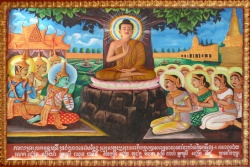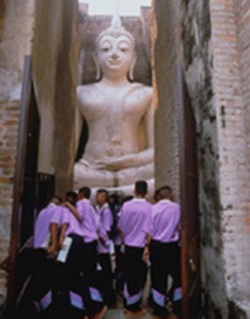Pali study - the meaning of 'sankhara'
sankhara can be a thing, a process or activity
for example, in the pali phrase 'sabbe sankhara anicca', sankhara means all conditioned things, eg. rocks, eyes, thoughts, etc
[quote]277. "All conditioned things are impermanent" — when one sees this with wisdom, one turns away from suffering. This is the path to purification.
278. "All conditioned things are unsatisfactory" — when one sees this with wisdom, one turns away from suffering. This is the path to purification.
279. "All things are not-self" — when one sees this with wisdom, one turns away from suffering. This is the path to purification.
Dhammapada
in the term, sankhara khanda, sankhara is the aggregate or function of mind that concocts emotions, thoughts, etc
Bhikkhus, why do they speak of sankhara? Bhikkhus, this nature naturally concocts concocted things (abhisankharonti), for this reason it is called "sankhara." What does it concoct? It concocts rupa as something concocted with "formness," it concocts vedana as something concocted with "feelingness," it concocts sanya as something concocted with "recognition-ness," it concocts sankhara as something concocted with "concoctingness," it concocts vinyana as something concocted with "cognition-ness." Bhikkhus, this nature naturally concocts concocted things, for this reason it is called "sankhara."
SN 22.79
or the term sankhara can mean the activity of concocting or proliferating itself
sankhara paramam dukham; nibbanam paramam sukham
203. mental concocting is the worst suffering; Nibbana [the stilling of concocting] is the highest bliss.
Dhammapada
in dependent origination, sankhara are the things that condition the body, speech and mind
"And what are fabricators? These three are fabricators: bodily fabricators, verbal fabricators, mental fabricators. These are called fabricators. SN 12.2
"Now, lady, what are fabricators?"
"These three fabricators, friend Visakha: bodily fabricators, verbal fabricators & mental fabricators."
"But what are bodily fabricators? What are verbal fabricators? What are mental fabricators?"
"In-&-out breaths are bodily fabricators. Directed thought & evaluation are verbal fabricators. Perceptions & feelings are mental fabricators."
"But why are in-&-out breaths bodily fabricators? Why are directed thought & evaluation verbal fabricators? Why are perceptions & feelings mental fabricators?"
"In-&-out breaths are bodily; these are things tied up with the body. That's why in-&-out breaths are bodily fabrications. Having first directed one's thoughts and made an evaluation, one then breaks out into speech. That's why directed thought & evaluation are verbal fabricators. Perceptions & feelings are mental; these are things tied up with the mind. That's why perceptions & feelings are mental fabricators." MN 44
With contact as a requisite condition, there is feeling. What one feels, one perceives (labels in the mind). What one perceives, one thinks about. What one thinks about, one complicates. Based on what a person complicates, the perceptions & categories of complication assail him/her with regard to past, present, & future... MN 18
It is the last application of sankhara, namely in dependent origination, which the scholars & translators do not understand. As MN 44 and MN 18 show, thought fabricates speech and perception & feeling fabricate the mind, namely, cravings, thoughts, mental suffering, etc. Thought is not the 'verbal fabrication' and feeling & perception are not the 'mental fabrication'. Thought is the verbal fabricator and feeling & perception are the mental fabricator. The same with the in breath & out breath. This is not the 'body fabrication' but the body fabricator.
I would like to take this opportunity to discuss all the meanings of the term "sankhara." This is a very common and important word in the Pali scriptures, but many people have problems with it due to its different uses and meanings. The single word "sankhara" can mean "conditioner," the cause that conditions; it can mean "condition," the result of the action of conditioning; and it can mean "'conditioning," the activity or process of conditioning. We use the same word for the subject of the conditioning, "the concocter," as well as the object, "the concoction." We even use it for the activity, "the concocting," itself. This may be a bit confusing for you, so please remember that "sankhara" has three meanings. The correct meaning depends on the context. This knowledge will be valuable in your further studies.
In the first steps of this practice, those concerned with the kaya (body), we study the breath in a special way. We note every kind of breath that occurs and study what each is like. Long breaths, short breaths, calm breaths, violent breaths, fast breaths and slow breaths: we must know them all. Of all the different kinds of breath which arise, know what nature each one has, know its characteristics and know its functions.
Observe what influence the different breaths have upon the flesh-body. The breath has a great influence on the rest of the physical body and this influence needs to be seen clearly. Observe both sides of the relationship until it is obvious that they are interconnected and inseparable. See that the breath-body conditions and concocts the flesh-body. That is the first step. Make a special study of the breath. Know the characteristics of all its different forms. Then understand that it is connected to this flesh-body too. This will allow us to regulate the flesh-body by means of regulating the breath.
In step three - "experiencing all bodies," experiencing both the breath and this flesh-body - each of these three meanings is practiced. First, we contemplate the flesh-body as the thing conditioned by the breath. Then, we see the breath as the conditioner of the flesh-body. Lastly, we observe the activity of conditioning that always exists simultaneously between the two of them. Thus, in the practice of step three we see the conditioner, the condition, and the action of conditioning. This conditioning of the body is the physical level of sankhara. We have not yet seen it on the mental level. Step three is this work of seeing these three things together, simultaneously and continuously, within the mind. Then, you will see everything concerning the term "sankhara," especially as it relates to the kaya and its activity, right here in step three.
When we have studied this fact until it is plainly, obviously and universally understood as explained above, then we will be able to experience all three of these facts together in one moment. Even for the duration of just one in-breath, or for just one out-breath, we can experience all three facts in just one stroke of the breath. If we are able to do so, then we have "fully experienced the kaya-sankhara (body-conditioner)" and step three is successfully completed.
The essence of practicing step three is to know that there are two kaya, and to be able to regulate one kaya through the other kaya. That is, we can regulate the flesh-body through the breath-body. Once we are certain or this, once we see it clearly, once we are convinced by our experience of this fact with each in-breath and out-breath, then we have realized success in our practice of step three.
Bhikkhu Buddhadasa



